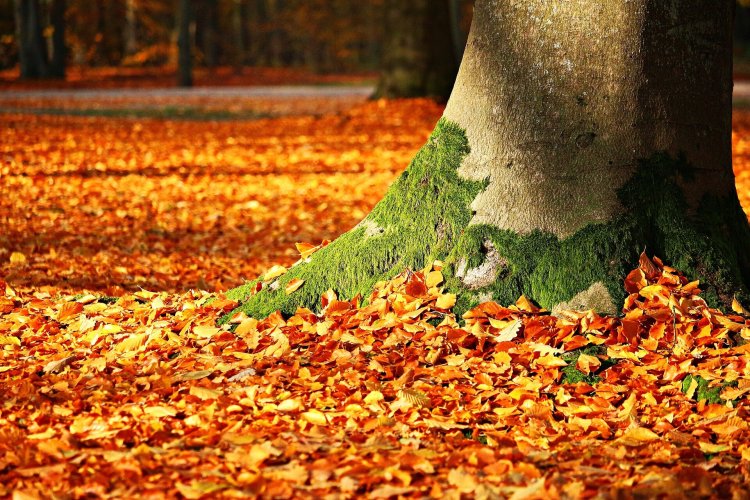We could save 6 lakh tonnes of CO2 every year just by leaving garden waste alone

Copenhagen, Denmark: Danes transport almost a million tonnes of yard garbage from their gardens each year. According to the estimates of University of Copenhagen professor Per Gundersen, if we just left the environment alone, we would be doing a wonderful service. At the same time, leaves and other garden trash are good for the soil and biodiversity in the garden.
The sound of a leaf blower blasting leaves into piles or the sight of a queue of garden waste-packed trailers at the recycling center is all too common as trees drop their golden brown and yellow robes in the fall.
The majority of Danes are content to "tidy up" their gardens. According to estimates from the Ministry of Environment, Danes disposed of 983,000 tonnes of garden garbage in 2019, all of which is transported, sorted, and processed by municipal waste management systems. Small branches, leaves, and grass clippings are composted, while larger branches and trunks are burned for bioenergy.
However, we should probably leave more of our garden alone. According to Per Gundersen, a professor of forest ecology at the University of Copenhagen's Department of Geosciences and Natural Resource Management, there are significant CO2 reductions to be had. Professor Gundersen analyzed the implications for Denmark's national climate account if Danes just let their garden waste decompose rather than burning it.
"If everyone went all-in and learned how to manage their garden's branches and twigs, for example, my calculations suggest that we could store about 600,000 tons of CO2 annually," he says.
The calculations are based on a straightforward model that includes the various decomposition processes for leaves, twigs, and branches.
When Gundersen subtracts the utility that the current system's branches and trunks give for bioenergy, the CO2 storage capacity of garden waste could meet roughly half of Denmark's 70% reduction target for 2030.
"When garden waste is burned or composted by municipal waste schemes, CO2 is returned to the atmosphere very quickly. By keeping waste in the garden, the decomposition process is significantly slower. In practice, this means that one builds up a larger and larger storage of CO2 in the garden in the form of twigs, dead branches, and leaves that are left to decompose," says Professor Gundersen.
Autumn leaves are good for the garden and biodiversity
Leaves are flying about and filling up yards at this time of the year. But instead of raking them up and hauling them off to a recycling center, there are other great reasons to leave them in the yard."Leaves help nourish the garden as they feed an entire ecosystem of decomposers. From fungi, bacteria, and tiny, invisible soil creatures to earthworms and roly-poly bugs, which help break down and metabolize organic material so that nutrients are released into the soil. These decomposers then act as an important food source for larger animals like hedgehogs and birds," explains Per Gundersen.
As microorganisms, worms, and other decomposers wage war on the leaves, a large part of the biomass ends up as CO2 that is slowly released into the air over several years. A small portion of the gnawed leaves becomes soil humus, a common name for the complicated organic material that takes a very long time to decompose and is of great importance for plant health.
"A high humus content in topsoil makes for a dark soil that has a good structure and retains water and nutrients well, which is important if you want garden plants to thrive," says Per Gundersen.
Facts:
* According to the Danish Ministry of Environment, Danes discarded 983,000 tonnes of yard debris in 2019. Garden debris from companies and parks is included in this statistic.
* The garden waste absorbs CO2 from the atmosphere. When converted, this quantity corresponds to around 1.2 million tonnes of bound CO2.
* If Danes left their garden trash in their yards and deducted the amount of garden waste utilized for bioenergy, Denmark's 70 percent reduction target for 2030 might be met by nearly half of one percent. *CO2 is the most abundant gas in leaves.
* Leaves are little CO2 reservoirs that receive CO2 from the air and release some of it during decomposition.
* Leaves decay in 3-6 months, until half of them remain (their half-life), whereas twigs and branches require 2-5 years. Tree trunks deteriorate over a period of 10-20 years.
We must dare to let go of control
But what to make of all those leaves suddenly filling up the garden? Per Gundersen suggests raking them into planting beds where vegetables are grown, or over to areas where you want to avoid weeds. They can also be gathered in a part of the garden that you may be willing to let grow wild and manage themselves.
"Funnily enough, while the wind tends to blow leaves around the garden, they often remain in beds or around bushes where there is less wind, which is a good thing," he says.
By spring, many of the leaves will have dissolved and returned to the invisible garden cycle. Linden and ash tree leaves are particularly adept at dissolving quickly in gardens. Oak and fruit tree leaves degrade more slowly, making them perfect for soil insulation around bulbous plants or vegetables.
"Our gardens can contribute to both the climate and biodiversity crisis by harnessing more garden waste. I also think that it will lead to a little less gardening in the long run. And then it's more fun because there will be a greater abundance of life around the garden. We just need to dare to let go of control and make more room for nature by allowing for twigs and a few dead branches, for example" concludes Per Gundersen.















































